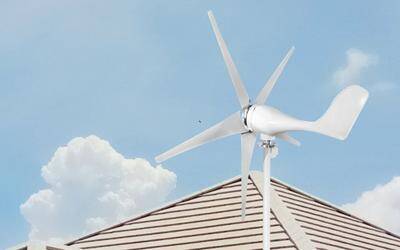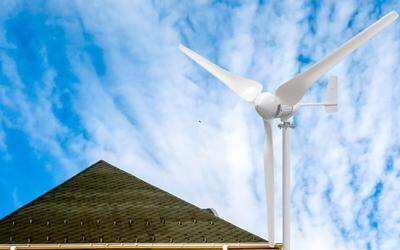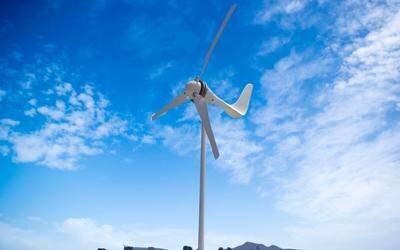TheRoundup is reader supported. We may earn a small commission when you make a purchase via links on this site, at no cost to you.
All products are personally reviewed and tested in accordance with our Review Methodology.

When it comes to finding the best home wind turbine, there are a lot of factors to consider.
Some people might be looking for the cheapest option, while others might be looking for the most efficient or powerful option.
Our recent guide on the cost of home wind turbines explains the costs and benefits of owning and maintaining a domestic wind turbine, so I won’t go over old ground here.
Instead, I’ve tested and reviewed the best home wind turbine options currently available in the U.S.
I’ve compared their price, power output, and more to give you a better idea of what you can get for your needs and budget.
Read on and discover which home wind turbine is perfect for you!
The most important factor when choosing a home wind turbine is the power output. You need to know that it’ll be able to generate enough electricity for your needs.
So, to make your search as simple as possible, I’ve broken the list down into three categories:
They Say: Three-phase permanent magnet synchronous motor. Efficient and compact ac generator with high-performance NdFeB permanent magnet. A fully integrated voltage regulator that automatically shuts down when energy is fully charged. The wind generator is controlled by MPPT intelligent microprocessor, which can effectively adjust current and voltage.
We Say: The Pikasola Wind Turbine Generator is my ’up to 500W’ overall winner because it’s a great all-rounder that ticks most of the boxes I look for in a wind turbine…at an excellent price!
For under 270 bucks, you get a compact home wind turbine built to last, thanks to its special coatings that provide corrosion, water, and sand resistance.
It comes packed with many features that you’d expect to find on a higher-priced turbine, such as:
A three-phase magnetic synchronous motor to create power efficiently
A fully integrated voltage regulator ensures that the device shuts down when the battery is fully charged
Internal microprocessor to control the current and voltage and ensure that the turbine is working at peak efficiency at all times
Magnetic circuit design to provide low starting torque (meaning it can work in wind speeds as low as 5.60mph)
Uses only the highest quality stainless steel and aluminum
If you’re new to the world of home wind turbines and free electricity, this Pikasola offering is a great place to start.


They Say: Made for both land and marine. Integrated automatic braking system to protect from sudden and high wind speed. Easy DIY installation methods with all materials provided. Can be used in conjunction with solar panels. MPPT Maximum power point tracking built into the wind turbine generator. Made with high-quality Polypropylene and Glass Fiber material with a weather-resistant seal.
We Say: The Automaxx Windmill (DB-400) 400W 12V Wind Turbine Generator Kit is a great little addition to any home that wants to power something small, such as a pond pump or outside lighting.
The turbine is very easy to install, and the fact you can use it in conjunction with solar panels makes it even more versatile.
I was impressed with the quality of the materials used, and the weather-resistant seal helps to protect against the elements.
An anti-surge feature applies brakes when the wind gets too intense.
For added peace of mind, this turbine is rated for use in heavy rains and can survive category 3 level hurricane winds.
One downside is that the minimum wind speed required for it to function is relatively high, but overall this is an excellent low-powered wind turbine.
Another is the price. It’s more than $500 more expensive than the Pikasola.
However, if you have the budget and want a small turbine that can withstand high winds, rain, or even ocean use, this is worth serious consideration.


They Say: The 12V 500W wind turbine generator with a charge controller is easy to install and maintain. The 5-blade three-phase AC permanent magnet synchronous generator runs freely and has low noise. You can use this wind turbine motor for wind power generation indoors or outdoors, such as power supply for boats, pavilions, or lighting.
We Say: If you’re looking for a low wind power option, Dyna-Living is your best bet.
With a rated power of 500W and a minimum wind speed of just 4.47mph, it can produce decent amounts of energy in the merest of breezes.
You don’t have to worry about extremes of temperature either. This wind turbine has an operating range of -40°C to 80 °C.
Not only does the five-blade design enable the turbine to operate at lower wind speeds, but it also makes the whole operation whisper quiet.


They Say: The aluminum alloy case of the wind turbine is light and low vibration. Optimized design of aerodynamic contour and structure enables the generator to start up at low wind speed and improve the utilization of wind energy. Adopts mechanical and electromagnetic dual over-speed control design, improving safety and reliability in operation. Auto windward direction adjustment.
We Say: This turbine was the best 1,000W offering I tested, and it deserves its place as the up to 1,000W overall winner.
The Tumo-Int 1000W three lightweight injection-molded blades each have a unique aerodynamic shape that helps to produce power at low wind speeds. It’s designed to work best in heavier winds, but the fact that the blades are optimized for low-speed winds means that this turbine will generate energy more often, resulting in lower yearly electricity costs.
This turbine comes with a three-year warranty to protect against costly repair bills caused by manufacturing defects.
The manufacturer states that with proper installation and care, the Tumo-Int 1000W will give you at least 15 years of faithful service.
To be fair, I think that’s the manufacturer being cautious. Judging by the build quality of this wind turbine, I can see it lasting at least 25 years with proper maintenance.
The outer shell is rust and weather-resistant, ensuring that the turbine will function in temperatures as low as -40°C and as high as 80 °C.
A solid piece of kit that’ll happily generate power for you for decades.


They Say: The wind turbine is made entirely of high-quality aluminum and stainless steel fittings. The blade material is made of high-strength plastic with 30% carbon fiber and anti-UV anti-corrosion material, which is both beautiful and durable. The surface of the wind turbine is coated with a special process that provides excellent resistance to oxidation and corrosion under any harsh conditions.
We Say: This 1,000W turbine is the second Pikasolar offering on the list.
It’s made to the same standard as the 500W model; it’s just heavier and produces more power.
The spec is similar to the Tumo-Int 1000W, except for the fact that this has a smaller rotor diameter and doesn't have the 48V option.
Pikasolar are a sturdy brand and considering the small(ish) outlay, it won't take long for these wind turbine kits to pay for themselves and start generating power to save you some money on your energy bills.


They Say: With groundbreaking technological advances that our team has made through years of research, we are proud to bring you a versatile wind turbine that is small, light, and compact enough so that it can be used in both residential and small commercial areas. The wind turbine is made to withstand harsh weather conditions such as the sun’s harsh UV rays, heavy rains, and up to level 3 category hurricane. The 3 fiberglass blades and tail is cut to precision to the finest millimeter in order to keep it light and working at 100% efficiency.
We Say: Now we’re getting to the big boys, capable of potentially supplying all your electric needs from wind power.
My overall winner in this category is this powerhouse from Automaxx.
The Windmill 1500W is a high-performance wind generator kit. It’s the most expensive option on the list, but with good reason…it’s one of the most powerful home wind generator kits currently readily available in the U.S.
The built-in overcharge and over-speed protection mean you don’t have to worry about disassembling it in extreme weather conditions.
There is also a manual brake, which is useful when assembling, disassembling, or relocating the turbine.
Bluetooth connectivity and a built-in Amp meter display are notable features that set this home wind turbine apart as a premium product.
Number Of Blades: The fewer blades a turbine has, the faster it spins (generating more power). More blades produce less power overall but will rotate in lighter wind. Three is most common and usually ideal for most circumstances.
Size Of Blades (Rotor Diameter): Larger blades can capture more wind and produce more power.
Weight: A heavier turbine will be harder to install (for example, on a pole in your yard rather than on your roof) and maintain.
Rated Power Output: This tells you the maximum power output the turbine can produce.
Wind Speed Rating: This tells you the wind speeds at which the turbine will generate maximum power output.
Minimum Wind Speed: This is the minimum wind speed it takes to turn the turbine blades.
Maximum Wind Speed: This is the max wind speed the turbine can operate in before damage is caused.
Voltage: A higher voltage will mean the turbine can power more appliances but may require a professional to install.
Warranty: Wind turbines at the higher end of power output are expensive purchases. Where possible, look for manufacturers that back their products with warranty periods to protect yourself from the expense of unexpected breakdowns.
Wind turbines work best in rural locations where wind speeds are high, and the flow to the turbine is unhindered by tall buildings.
Urban areas produce chaotic wind flow, which cannot be harnessed efficiently by current wind turbine technology.
The future of harnessing urban wind could be the O-Wind Turbine.
It won the James Dyson award in 2018 and is now in advanced R&D and testing.
It looks like it’ll be a few more years before it reaches the market. However, when it does, it has the potential to revolutionize urban wind energy planning.
Some local zoning codes prohibit home wind turbines, so always double-check before buying.
The reason for the prohibition is often to protect local wildlife (mainly birds and bats).
According to the U.S. Fish and Wildlife Service, between 140,000 and 500,000 birds are killed by wind turbines in the U.S. every year.
However, some experts believe there’s a simple way to drastically reduce this number. Make the blades more visible by painting them black.
There are three main types of home wind turbine design:
Horizontal-Axis Wind Turbines: Blades that spin around a horizontal shaft. These are the most common types of wind turbines.
Vertical-Axis Wind Turbines: Blades that spin around a vertical shaft. These are less common but still effective.
Ducted Wind Turbines: Blades that are enclosed in a shroud or duct. These are used in situations where space is limited, like offshore wind farms.
According to WINDExchange, the top five windiest states are:
The best wind turbines can withstand wind speeds well in excess of 100mph.
To go off-grid, you’ll need to generate 5-15 kW of power, which isn’t feasible with most home wind turbines.
To reach that energy production figure, you’d need to combine several wind turbines with solar or micro-hydro systems.
Most homeowner insurance policies cover home wind turbines, but it’s always a good idea to check with your insurer first. Some companies may require you to purchase a separate policy for the turbine.
In some cases, yes.
Depending on your location and the utility company you’re connected to, you may be able to sell excess energy production back to the grid. This is called "net metering," and it can help offset the cost of your turbine.
Combining your wind turbine with solar panels will boost your green energy earnings even further.
You should dispose of wind turbine blades responsibly. However, very few places can recycle end-of-life wind turbine blades.
If you’re feeling creative, they could make eye-catching wall art or a conversation-starting garden feature.
Home wind turbines need wind to generate power, so they’re not of much use when it’s calm.
However, most turbines are designed to operate in a range of wind speeds, so they can still generate some power even when the wind is light.
Installing wind turbines on your house or land is a great way to generate clean green electricity.
However, it might not be for everyone. The upfront cost can be high, and there is some level of maintenance and ongoing cost involved.
Before deciding if a home wind turbine is right for you, ask yourself the following questions:
It’s worth bearing in mind that the home wind turbine market is relatively new (especially when compared to solar panels), and technology is progressing all the time.
If you’re new to all this and fancy dipping your toe in the water, I’d recommend starting with a small wind turbine and seeing how you get on.
Most wind turbines (and all of the recommendations in this article) are sold as a wind turbine kit, perfect for beginners who want to generate electricity but might not have everything they need immediately to hand.
Do you already have a residential wind turbine set up on your roof, RV, boat, or in your yard?
Do you use a residential wind turbine to power one specific item or your whole house? Drop me a line and let me know.

Our core values mean we always prioritize sustainability over profit. We carefully evaluate and personally test every product to ensure they meet our high standards. All products recommended in this article were tested in accordance with our Review Methodology.
TheRoundup.org - As Seen On
